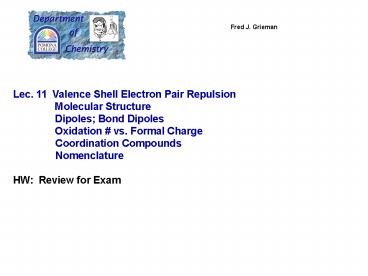Lec. 11 Valence Shell Electron Pair Repulsion PowerPoint PPT Presentation
1 / 11
Title: Lec. 11 Valence Shell Electron Pair Repulsion
1
Fred J. Grieman
Lec. 11 Valence Shell Electron Pair Repulsion
Molecular Structure
Dipoles Bond Dipoles Oxidation
vs. Formal Charge Coordination Compounds
Nomenclature HW Review for Exam
2
Molecule Lewis Dot SN
EP Structure Molecular Structure
.. .. OCO
CO2
O-C-O Linear bond
angle? 180
2
Linear
Trigonal Planar bond angle?
120
O .. .. OSO
SO3
3 Trigonal planar
Bent bond angle ? ?
120 (119.5)
..
.. .. .. OSO
3 Trigonal planar
SO2
Bent bond
angle? ? 120 (117.5 )
..
.. .. .. O?OO
3 Trigonal planar
O3
VSEPR
3
Molecule Lewis Dot SN EP Structure
Molecular Structure
H H ? C ? H H
CH4
H H \ / Tetrahedral C ?
?H H bond
angle ? 109.5
4 Tetrahedral
.. N Trigonal
Pyramid H ?? ?H H
bond angle ?
lt 109.5 (107.3)
.. H ? N ? H H
NH3
4 Tetrahedral
..
..
Bent bond angle ? lt 109.5 lt107.3 ? (104.5)
.. H ? O ? H
H2O
4 Tetrahedral
4
Molecule Lewis Dot SN EP
Structure Molecular Structure
F F F P F F
F Trigonal Bipyramid F
different angles F?P? ?F
90 120 F
PF5
5 Trigonal Bipyramid
120
90
90 interactions only important ones F
F axial r(PF)1.577Å F?P?
?F equatorial F
r(PF)1.534 Å
F F .. S F F
5 Trigonal Bipyramid
F F Seesaw S? ?F F
SF4
in axial or equatorial position? E(LP?BP)gtE(BP?B
P) Only 90 important
F F ?S? ?F F two 90
LP ? BP
.. F F?S? ?F
F three 90 LP ? BP
F Disorted Seesaw / F
? S? bond angle lt180 \?F
(173) F
5
Molecule Lewis Dot SN EP
Structure Molecular Structure
F .. Cl F F
ClF3
F .. T-Shape F?Cl?
angle lt 90? ?.. (87.5?)
F
5 Trigonal Bipyramid
I .. Linear? ? I? ?..
no 90? LP ? LP I
.. .. .. .. I ? I ? I
I3-
5 Trigonal Bipyramid
F F F S F F F
F F F Octahedral ?S? F
?F F
6 Octahedral
SF6
?
F F F Square Pyramid
?Br? F ?F
F F F Br F F
BrF5
6 Octahedral All positions equivalent
?
6
Molecule Lewis Dot SN EP
Structure Molecular Structure
F F .. I F
F
.. F F Square Planar ?I ?
Bond Angle 90 F F
6 octahedral E(LP ? LP) the largest
IF4-
?
?
7
The greater the electronegativity difference,
the larger the dipole.
Electric Field Off Electric Field On
Molecules Interacting Via Dipoles
8
Polyatomic molecules dipole from vector sum of
Bond Dipoles Structure Determined from VSEPR
important! Consider Polyatomic molecules as made
from diatomic molecules Examples
d- 2d d- CO2
OCO
µ 0 because bond dipoles equal, but OPPOSITE
Molecule is NONPOLAR
d- d ltd-
µ ? 0 because bond dipoles UNEQUAL opposite
Molecule is POLAR
OCS
COS
2d-
µ ? 0 because bond dipoles equal, but NOT
OPPOSITE Molecule is POLAR
H2O
d
d
H H \ / C ? ?H H
Bond dipoles are equal, but opposite? Vector
addition gives so µ 0 What if add Cl in
place of H? Is molecule POLAR?
CH4
YES!
Cl
9
So!!! We see that molecules vary from ionic
to polar to
covalent
covalent NaCl HCl
Cl2 Indicate separation of
electrons with 3 different concepts Charge
(complete separation of e-)
Na Cl-
.. 0 Formal Charge (complete sharing of
bonding pairs) H - Cl
- Oxidation Number (Oxidation State)
- Charge on atoms in molecule as if the compound
is ionic. - For ionic compounds just ionic charge
- For polar covalent and covalent compounds
assume most - electronegative element gets all of shared
electrons - 1 H Cl -1
- Formal Charge --- Oxidation Number
Covalent --- Ionic Limits
10
Metals down in Groups III, IV, V and Transition
Metals can often have different oxidation
states E.g., Fe2 Fe3
Sn2 Sn4 FeO
Fe2O3 SnCl2
SnCl4 Iron(II) oxide Iron(III)
oxide Tin(II) chloride Tin(IV) chloride
Oxidation state indicated by Roman Numeral in Name
Transition Metals Often Form Coordination
Complexes in solution and solid
state E.g., Co2(aq) 4Br-(aq) ?
Co(Br)42-(aq) Fe2(aq) 3C2O42-(aq)
? Fe(C2O4)34-(aq) Complex ions in solution
11
Nomenclature Will not lecture
Will provide handout Not on the first
exam Exam 1 55 minutes Closed Book Bring
Pencils and Calculator Scratch Paper and Periodic
Table Provided Study Sheet Will be sent via
email QA Session - Saturday, Seaver N 111, Time
???

